|
|
| |
SPAIN
SEVILLE
Seville is the capital of Andalucia and the the artistic, historic, cultural, and financial capital of southern Spain. It is situated on the plain of the River Guadalquivir. The population of the city of Seville was 704,198 as of 2010, ranking as the fourth largest city of Spain. The population of the metropolitan area (urban area plus satellite towns) was 1,508,605 as of 2010 (INE estimate). In the 19th century Seville gained a reputation for its architecture and culture. Seville has built on its tourism industry since, playing host to the International Exposition in 1992, which spurred the construction of a new airport, a new train station, a bullet train link to Madrid, new bridges and improvements to the main boulevards. Tourist facilities are top-notch and the city is buzzing with festivals, color and a thriving nightlife scene.
Sevilla International Airport is located about 25 minutes drive from the city center. A bus service "Especial Aeropuerto (EA) runs about every 30 minutes from just outside the "Arrivals" hall during most of the day. and costs approx. €2.40. Taxis are always available next to the bus stop and run on a fixed fare to Seville center, just under €18 during the day and just under €21 after 10PM and on weekends/holidays. Sevilla Santa Justa Station is on the eastern edge of Seville city centre. Completed in 1991, the station is the southern terminus of the Spanish high speed AVE train service. High-speed are great if time is of the essence, less than an hour from the wonderful city of Córdoba, less than three hours run from Madrid to Seville. However, slower trains remain a bargain, and there is an overnight train that runs from Barcelona to Seville in under 11 hours. Sevilla has a great public transportation system. The buses run frequently and cover the majority of the city in their routes. You can purchase bus cards at many news stands.
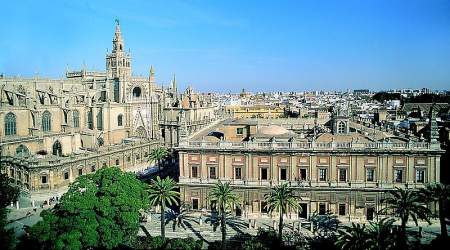 View of Seville Cathedral
Photograph © IgnisFatuus
Seville Cathedral
Seville Cathedral, is a Roman Catholic cathedral in Seville. It is the largest Gothic cathedral and the third-largest church in the world. At the time of its completion in the 16th century, it supplanted the Hagia Sophia as the largest cathedral in the world. Previously, the Hagia Sophia had held the title for almost a thousand years. The cathedral also serves as the burial site of Christopher Columbus. The Archbishop's Palace is located on the northeastern side of the cathedral. The cathedral was built to demonstrate Seville's wealth, as it had become a major trading center in the years after the Reconquista in 1248. The builders used some columns and elements from the mosque, and most famously the Giralda, a minaret converted into a bell tower. The Giralda is the city's most famous symbol. Its square base is 13.61 metres and a height of 105 metres. It was built as a minaret of the old mosque, although the bell tower and spire top, is Renaissance. The cathedral has 80 chapels, in which 500 masses were said daily as reported in 1896.
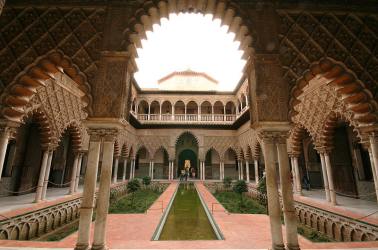 Patio de las Doncellas
Photo: Cat from Sevilla, Spain
The Alcázar of Seville is a royal palace in Seville, originally a Moorish fort. The palace is one of the best remaining examples of mudéjar architecture. Subsequent monarchs have added their own additions to the Alcázar. The upper levels of the Alcázar are still used by the royal family as the official Seville residence and are administered by the Patrimonio Nacional. The "Baths of Lady María de Padilla" are rainwater tanks beneath the Patio del Crucero. The tanks are named after María de Padilla, the mistress of Peter the Cruel. The Casa de Contratación (House of Trade) lies off the la Monteria. It was built in 1503 by the Catholic Monarchs to regulate trade with the New World colonies. The Casa dealt with trade related legal disputes on trade with the Americas. The "Casa" includes a chapel where the Colombus met with Ferdinand and Isabella after his second voyage. The chapel houses the The Virgin of the Navigators, one of the first paintings to depict the discovery of the Americas and one of the earliest paintings to depict Columbus.
Torre del Oro
The Torre del Oro is a dodecagonal military watchtower in Seville, southern Spain. It was built by the Almohad dynasty in order to control access to Seville via the Guadalquivir river. Constructed in the first third of the 13th century, the tower served as a prison during the Middle Ages and as a secure enclosure for the protection of precious metals periodically brought by the fleet of the Indies, another possible origin for the tower's name. The tower is divided into three levels, with the third and uppermost being circular in shape and added in 1760. This tower has a lesser-known half sister: the Torre de la Plata, an octagonal tower. It is one of two anchor points for a large chain that would have been able to block the river. The other anchor-point has since been demolished or disappeared, possibly from collapsing during the 1755 Lisbon Earthquake. Today the tower, having been restored, is a naval museum, containing engravings, letters, models, instruments, and historic documents. The museum outlines the naval history of Seville and the importance of its river.
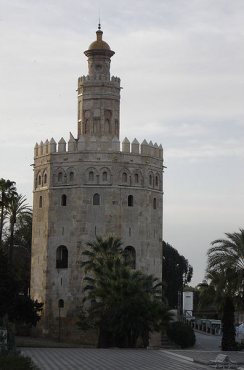 Torre del Oro
Photo: Lobillo, (España)Plaza de España
The Plaza de España is a plaza located in the Parque de María Luisa. It was built in 1928 for the Ibero-American Exposition of 1929. the Ibero-American Exposition of 1929. It is a landmark example of the Renaissance Revival style in Spanish architecture. In 1929 Seville hosted the Ibero-American Exposition World's Fair, located in the celebrated Maria Luisa Park. It was designed by Jean-Claude Nicolas Forestier. The entire southern end of the city was redeveloped into an expanse of gardens and grand boulevards. The centre of it is Parque de María Luisa, a 'Moorish paradisical style' with a half mile of: tiled fountains, pavilions, walls, ponds, benches, and exhedras; lush plantings of palms, orange trees, Mediterranean pines, and stylized flower beds; and with vine hidden bowers. Numerous buildings were constructed in it for the exhibition. The Plaza de España, designed by Aníbal González, was a principal building built on the Maria Luisa Park's edge to showcase Spain's industry and technology exhibits. González combined a mix of 1920s Art Deco and 'mock Mudejar', and Neo-Mudéjar styles. The Plaza de España complex is a huge half-circle with buildings continually running around the edge accessible over the moat by numerous beautiful bridges. In the centre is a large fountain. By the walls of the Plaza are many tiled alcoves, each representing a different province of Spain. Today the Plaza de España mainly consists of Government buildings. The Seville Town Hall, with sensitive adaptive redesign, is located within it.
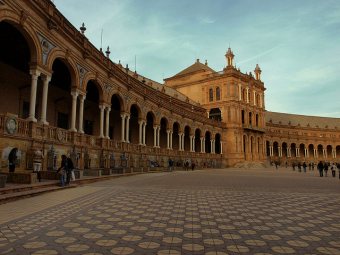 The Plaza de España in Seville
Photo: hozinjaMetropol Parasol
Metropol Parasol is a wooden building placed in La Encarnación square, in the old quarter of Seville. It was designed by the German architect Jürgen Mayer-Hermann and completed in April 2011. It has dimensions of 150 by 70 metres (490 by 230 ft) and an approximate height of 26 metres (85 ft). The building is popularly known as Las Setas de la Encarnación (Encarnación's mushrooms). Metropol Parasol is organized in four levels. The underground level-0 houses the Antiquarium, where Roman and Moorish remains are displayed. The level-1 (street level) is the Central Market. Level-2 and 3 are the two stages of the panoramic terraces (including a restaurant), offering one of the best views of the city center.
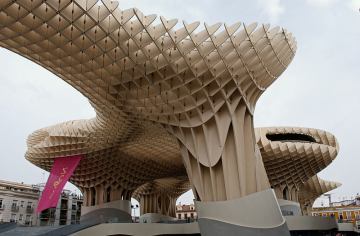 Metropol Parasol
Photo: Anual
The Palace of San Telmo is a historical edifice in Seville. Is it now the seat of the presidency of the Andalusian Autonomous Government. It was originally constructed as the seat of the Seminary School of the University of Navigators a school of orphan children of sailors. The principal façade of the palace is distinguished by the magnificent Churrigueresque entrance completed in 1754, the work of other members of the Figueroa family, specifically Matías and Antonio Matías, son and grandson of Leonardo de Figueroa, at a cost of 50,000 pesos. The entryway consists of several parts. The door is flanked by three columns on each side. Over the door is a balcony supported by Atlantes (supports sculpted in the form of a man) with aspects of indigenous people of the Americas; twelve allegorical female figures represent the nautical arts and sciences.
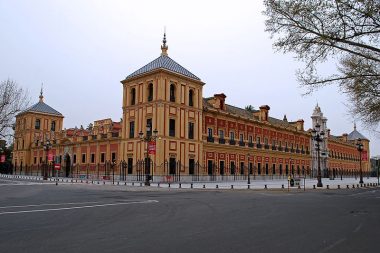 Palace of San Telmo
Photo: Anual
The Museum of Arts and Traditions of Sevilla is a museum in Seville. It is located in the María Luisa Park, across the Plaza de América from the Provincial Archeological Museum. The public portion of the museum occupies the lower-ground floor, the main floor, and the additional floor (now "first floor") that was created by Delgado Roig. The upper floor contains the museum library (specialized in ethnography and museology). There is also a photo archive, audiovisual and conference rooms, as well as a restoration studio and a photography laboratory. Temporary exhibitions can be visited independently of visiting the rest of the museum. Most of the items in the museum date back to its original collection. The museum was founded as a section of the Museum of Fine Arts, and the largest and most significant portion of the collection came from that museum. Particularly notable are the Aguiar collection of costumbrista paintings; the Soria collection of Oriental porcelain and ivory; and some pieces from the Orleans and Gestoso collections. The collection of Andalusian popular ceramics has developed over time, and is rivaled only be the collection at the Museum of Ethnology, Hamburg.
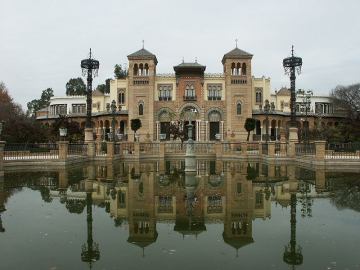 Museum of Arts and Traditions of Sevilla
Photo: Arriqui
The Maria Luisa Park is a public park that stretches along the Guadalquivir River in Seville. It is Seville's principal green area. In preparation for the exhibition, the entire southern end of the city was redeveloped into an expanse of gardens and grand boulevards. The centre of it is Parque de María Luisa, a 'Moorish paradisical style' with a half mile of tiled fountains, pavilions, walls, ponds, benches, and exhedras. There are lush plantings of palms, orange trees, Mediterranean pines, and stylized flower beds and with bowers hidden by vines. The park serves as a botanical garden. Many plant species, native or exotic, are represented, along with educational panels to inform the visitors to the park. Many birds make their home in the park, which is known for its large population of doves. here are also many green parrots living in the center of the park and ducks and swans in the fountains and lakes. The park is home to many monuments, and to numerous ponds and fountains. Among the most famous are the Fountain of Lions (Fuente de los Leones) and the lotus pool (Estanque de los Lotos).
|
|
|
Festivals & Events
Seville Fair
The Feria de abril de Sevilla, literally Seville April Fair, is held
in the Andalusian capital of Seville, Spain. The fair generally begins
two weeks after the Semana Santa, or Easter Holy Week. The fair
officially begins at midnight on Monday, and runs six days, ending on
the following Sunday. Each day the fiesta begins with the parade of
carriages and riders, at midday, carrying Seville's leading citizens
which make their way to the bullring, La Real Maestranza, where the
bullfighters and breeders meet.
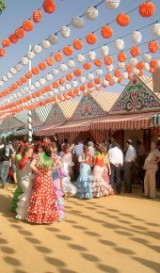 Casetas at Seville Fair
Photo: EdTarwinski
San Fermín
The festival of San Fermín is renowned for it's celebratory
tradition and is held in Pamplona anually on the 6th July. It is known
locally as Sanfermines and is held in honour of Saint Fermin. This
festival is important in terms of Spanish folklore and tradition. The
week long fiesta is most famous for it's encierro (running of the
bulls). It is belived that a million people flock to see this event
every year. The opening of the fiesta is marked by setting off the
pyrotechnic chupinazo. The rocket is launched at 12:00 noon on the 6th
of July from a city hall balcony with thousands of people celebrating
the act in the city hall square and other locations in Pamplona.
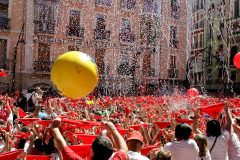 San Fermín Festival seen from
the Town Hall in Pamplona
Photo: Viajar24h
Fiestas del Pilar
Fiestas del Pilar is a large festival that takes place in Zaragoza,
Spain. This festival is religiously rooted in Spain and based on the
belief that Virgin Mary appeared to Saint James standing on a pillar.
The celebration lasts for seven days during which the city is bustling
with energy as over two million people visit the city for this fiesta.
Every day at 8 o'clock in the morning there is an event called
vaquillas, that is amateur bullfighting in the towns bullfighting ring,
or Plaza de toros. Everyone who is brave enough, can participate in this
event, in which many people get injured every year. The most important
celebration takes place on the 12th October, "The offering of flowers"
to the Virgin, who is removed from the Basilica and exhibited in a
platform placed on the square where the temple lies. The Offering of
Flowers is one of the more famous festive symbols of Spain.
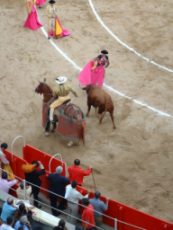 San Fermín Festival seen from
Bull running in Barcelona
Photo: BPG
Carnival
Carnival is a festive season which occurs immediately before Lent;
the main events are usually during February. Carnival typically involves
a public celebration or parade combining some elements of a circus,
mask and public street party. The Santa Cruz de Tenerifeand Las Palmas
de Gran Canaria is together with the Carnival of Cadiz, the most
important festival for Spanish tourism and Spain's largest carnival. In
Catalonia people dress up and organise parties for a week but
particularly on the weekend. Despite it being winter, parties are open
air, beginning with a cercavila to call everybody to come. Rues of
people dance along the streets. On Thursday Dijous Gras is celebrated,
also called 'the omelette day' and omelettes are eaten. Parties end by
burning Mr. Carnestoltes and with enterrament de la sardina (sardine's
funeral). Carnaval de Solsona takes place in Solsona, Lleida in central
Catalonia. It is one of the longest carnivals in Catalonia; free events
in the streets, and concerts every night, run for more than a week.
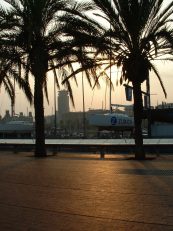 Barcelona harbour
Photo: BPG
Festival Internacional de Benicàssim
The Festival Internacional de Benicàssim is an annual music festival
sponsored by a well known beer label which takes place in the village of
Benicàssim, province of Castelló, Valencian Community in Spain. It
focuses mainly on pop, rock and electronica artists, as well as having
other elements besides music like short films, theatre, fashion and art.
Since the first festival in 1995, some of the most notable artists who
have played the festival include Paul Weller, Depeche Mode, Beck,
Radiohead, Kraftwerk, The Stone Roses, Brian Wilson, Blur, Lou Reed,
Oasis, The Chemical Brothers, Franz Ferdinand, The Killers, Morrissey,
Sigur Rós, Ride and The Strokes. As of 28 January, the line up for the
2011 Festival is as follows: Arcade Fire, Arctic Monkeys, Mumford &
Sons, Portishead, The Strokes, Beirut, Catpeople, Elbow, Friendly Fires,
Julieta Venegas, Lori Meyers, Primal Scream (present Screamadelica),
The Streets, Tinie Tempah, The Coronas, Grupo Salvaje, The Marzipan Man
Smile, Veronica Falls, Paolo Nutini, Pendulum, Mahmiri Acar. 'FIB' is
held in the seaside resort of Benicassim (Castellón province) on Costa
del Azahar, Valencia, Spain, 92.2 km away from Valencia Airport.
Festival goers who have purchased multi-day passes can camp for up to 9
days starting Monday before the festival starts and ending Tuesday after
the festival has ended. For more information please contact info@fiberfib.com
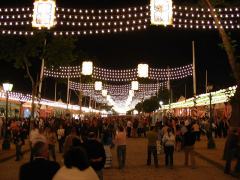
Festimad
Festimad is an alternative rock festival and cultural event held yearly
in Madrid, Spain since 1994, usually in the last week of May. Festimad
includes several parallel cultural festivals such as Performa, Graffiti,
Universimad o Cinemad, although its central event continues to be the
music festival, standing alongside the Festival Internacional de
Benicàssim as Spain's main rock concert. For more information please
contact festimad@festimad.es
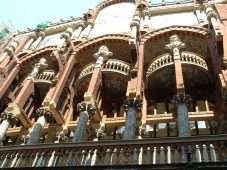 Photo: BPG
Bilbao Live Festival
The Bilbao Live Festival is a rock and pop music festival that takes
place in the summer in Bilbao, Spain since 2006. It is supported by BBK
the savings bank. Some 51,000 people attended the first edition of
Bilbao Live Festival in 2006, an event that reunited during three days
more than 40 national and international bands of rock and carps of
electronic music. Bilbao had thus burst in with force into the circuit
of great musical festivals of the summer time. The 2011 lineup includes
Coldplay, Blondie, Beady Eye, Crystal Castles, Russian Red, Ken Zazpi,
Amy Winehouse, Kasabian, Kaiser Chiefs, The Black Crowes, The Chemical
Brothers, Jack Johnson, 30 Seconds to Mars, M-Clan. For more information
please contact festivals@nme.com
|